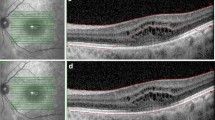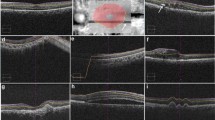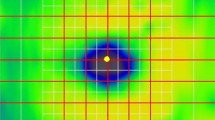Abstract
Background
Automatically measurements of retinal thickness by optical coherence tomography (OCT) facilitate the assessment of various retinal diseases.The aim of this retrospective study was to report macular thickness measurements in eyes with vascular pigment epithelial detachment (PED) due to age-related macular degeneration (AMD) by using two different commercially available spectral domain (SD) OCT instruments and to consequently point out differences in their algorithm software.systems.
Methods
OCT images of patients with vascular PED due to AMD, obtained with Cirrus and Spectralis OCT, were retrospectively analyzed. Main objectives were to observe differences in central retinal thickness (CRT) values and failures in automated threshold delineation, as well as central point thickness values obtained after manual correction of threshold lines. Scanning with the Cirrus HD OCT was performed with the 512 × 128 scan pattern; scans performed with the Spectralis OCT were 20 × 15 degree raster scans consisting of 19 high-speed line scans.
Results
OCT images of 34 eyes of 28 patients with a mean age of 71 years and a mean distance visual acuity (VA) of 0.70 ETDRS were analyzed. Mean central retinal thickness (CRT) was 262.38 μm ± 133.18 (176–507 μm) in Cirrus and 337.82 μm ± 137.75 (277–790 μm) in Spectralis scans,mainly caused by different software approaches in positioning the posterior threshold line, following the PED in Cirrus OCT whereas remaining unelevated in Spectralis OCT. There were failures in positioning the outer retinal boundary line in 50% of Cirrus scans and in 73.52% of Spectralis scans. We obtained the mean value of central point neurosensory retinal thickness of each central single scan after manual delineation, and found a significant correlation (r = 0.819, p < 0.001).
Conclusions
Our study indicates that there are significant differences in CRT values in patients with vascular PED, due to different segmentation algorithms and a high error rate in automatically set threshold lines. When planning and conducting multicenter studies, one has to be especially aware of the differences in delineating threshold algorithm lines by different SD OCT devices.




Similar content being viewed by others
References
Huang D, Swanson EA, Lin CP, Schuman JS, Stinson WG, Chang W, Hee MR, Flotte T, Gregory K, Puliafito CA et al (1991) Optical coherence tomography. Science 254(5035):1178–1181
Puliafito CA, Hee MR, Lin CP, Reichel E, Schuman JS, Duker JS, Izatt JA, Swanson EA, Fujimoto JG (1995) Imaging of macular diseases with optical coherence tomography. Ophthalmology 102(2):217–229
Fung AE, Lalwani GA, Rosenfeld PJ, Dubovy SR, Michels S, Feuer WJ, Puliafito CA, Davis JL, Flynn HW Jr, Esquiabro M (2007) An optical coherence tomography-guided, variable dosing regimen with intravitreal ranibizumab (Lucentis) for neovascular age-related macular degeneration. Am J Ophthalmol 143(4):566–583
Krebs I, Ansari-Shahrezaei S, Goll A, Binder S (2008) Activity of neovascular lesions treated with bevacizumab: comparison between optical coherence tomography and fluorescein angiography. Graefes Arch Clin Exp Ophthalmol 246(6):811–815, Epub 2008 Jan 15
Choma M, Sarunic M, Yang C, Izatt J (2003) Sensitivity advantage of swept source and Fourier domain optical coherence tomography. Opt Express 11(18):2183–2189
Wojtkowski M, Leitgeb R, Kowalczyk A, Bajraszewski T, Fercher AF (2002) In vivo human retinal imaging by Fourier domain optical coherence tomography. J Biomed Opt 7(3):457–463
Krebs I, Haas P, Zeiler F, Binder S (2008) Optical coherence tomography: limits of the retinal-mapping program in age-related macular degeneration. Br J Ophthalmol 92:933–935
Ahlers C, Simader C, Geitzenauer W, Stock G, Stetson P, Dastmalchi S, Schmidt-Erfurth U (2008) Automatic segmentation in three-dimensional analysis of fibrovascular pigment epithelial detachment using high-definition optical coherence tomography. Br J Ophthalmol 92(2):197–203, Epub 2007 Oct 26
Patel PJ, Chen FK, da Cruz L, Tufail A (2008) Segmentation error in Stratus optical coherence tomography for neovascular age-related macular degeneration. Invest Ophthalmol Vis Sci 50(1):399–404, Epub Aug 1
Sadda SR, Joeres S, Wu Z, Updike P, Romano P, Collins AT, Walsh AC (2007) Error correction and quantitative subanalysis of optical coherence tomography data using computer-assisted grading. Invest Ophthalmol Vis Sci 48(2):839–848
Krebs I, Falkner-Radler C, Hagen S, Haas P, Brannath W, Lie S, Ansari-Shahrezaei S, Binder S (2009) Quality of the threshold algorithm in age-related macular degeneration: Stratus versus Cirrus OCT. Invest Ophthalmol Vis Sci 50(3):995–1000
Leung CK, Cheung CY, Weinreb RN, Lee G, Lin D, Pang CP, Lam DS (2008) Comparison of macular thickness measurements between time domain and spectral domain optical coherence tomography. Invest Ophthalmol Vis Sci 49(11):4893–4897
Forooghian F, Cukras C, Meyerle CB, Chew EY, Wong WT (2008) Evaluation of time domain and spectral domain optical coherence tomography in the measurement of diabetic macular edema. Invest Ophthalmol Vis Sci 49(10):4290–4296
Wolf-Schnurrbusch UE, Ceklic L, Brinkmann CK, Iliev ME, Frey M, Rothenbuehler SP, Enzmann V, Wolf S (2009) Macular thickness measurements in healthy eyes using six different optical coherence tomography instruments. Invest Ophthalmol Vis Sci 50(7):3432–3437
Mylonas G, Ahlers C, Malamos P, Golbaz I, Deak G, Schütze C, Sacu S, Schmidt-Erfurth U (2009) Comparison of retinal thickness measurements and segmentation performance of four different spectral and time domain OCT devices in neovascular age-related macular degeneration. Br J Ophthalmol 93(11):1453–1460, Epub 2009 Jun 10
Hee MR (2005) Automated measurements of retinal thickness with optical coherence tomography. Am J Ophthalmol 139(1):18–29
Author information
Authors and Affiliations
Corresponding author
Additional information
Financial support
No financial support was provided for this study.
Conflicts of interest
The authors have no conflict of interest to declare.
An erratum to this article can be found at http://dx.doi.org/10.1007/s00417-010-1446-2
Rights and permissions
About this article
Cite this article
Smretschnig, E., Krebs, I., Moussa, S. et al. Cirrus OCT versus Spectralis OCT: differences in segmentation in fibrovascular pigment epithelial detachment. Graefes Arch Clin Exp Ophthalmol 248, 1693–1698 (2010). https://doi.org/10.1007/s00417-010-1415-9
Received:
Revised:
Accepted:
Published:
Issue Date:
DOI: https://doi.org/10.1007/s00417-010-1415-9




